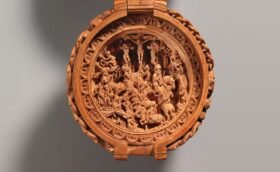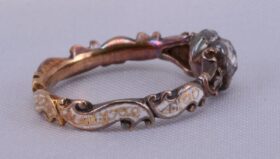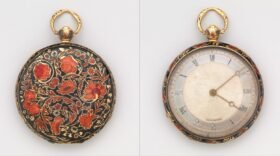
20 Jun A History of Antique Christ/Cross Watches
Seen Above: A 17th Century Christ-Cross Watch by Anthoine Arlaud in Gilded Silver, Brass, Steel, and Rock Crystal
In the history of horology, few artifacts resonate with the same quiet intensity as the antique watches designed around the cross or the figure of Christ. Produced between the late 16th and early 18th centuries, these timepieces were not merely tools for marking the passage of hours — they were meditative instruments, personal relics that united the divine and the mechanical in an object often small enough to fit in the palm of a hand.
These were the watches of pilgrims and princes, of the devout and the discerning. Shaped like crosses or delicately enameled with the Crucifixion, they reflected both spiritual devotion and the technical artistry of Europe’s finest watchmakers.
Time as a Sacred Measure
The era that birthed these Christ-themed watches was one in which religious identity shaped art, architecture, and personal possessions. The Reformation and Counter-Reformation had deeply divided Europe, but they also sparked an intense wave of religious patronage and symbolism, including in the world of luxury craftsmanship.
For a devout Catholic or Protestant noble, commissioning a devotional timepiece was not only an act of piety but also a declaration of taste and wealth. These watches functioned as portable altarpieces — mechanical prayers, one might say — worn close to the heart or displayed in moments of personal reflection.
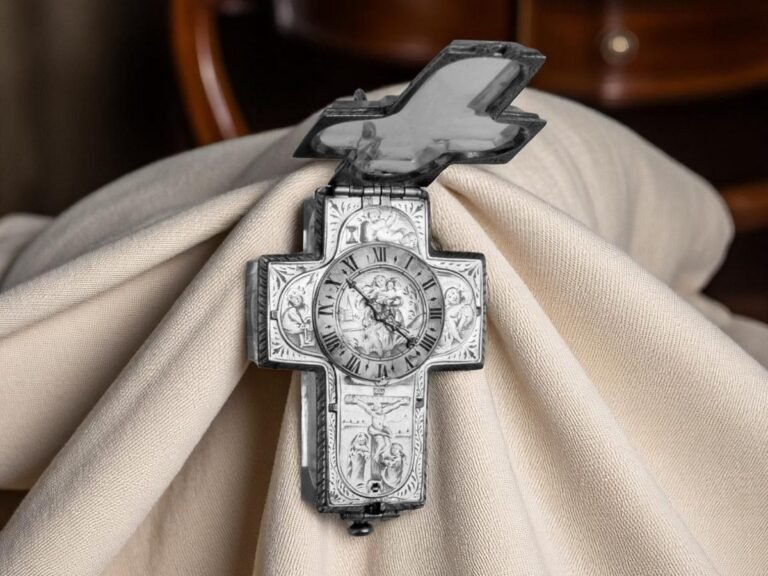
The Watchmakers of Faith
Several renowned watchmakers contributed to this tradition, and while many timepieces remain unsigned or attributed only through style and origin, the names of some masters endure.
Pierre-Martin Scheult (Geneva, late 17th to early 18th century)
Scheult is perhaps the most iconic figure associated with cross-shaped watches. Working in Geneva — a hub of Protestant craftsmanship and horological excellence — he specialized in timepieces housed in rock crystal, meticulously carved into cruciform shapes. These watches married the ethereal clarity of crystal with the rich warmth of gilded brass frameworks and delicately enameled dials. The movements were often finely engraved, and some featured miniature depictions of the Passion or Latin scripture, barely visible to the naked eye but deeply symbolic.
Abraham Bobinet (Blois, mid-17th century)
In Catholic France, Abraham Bobinet stood at the forefront of devotional watchmaking. Blois, where he worked, was famous not only for its watchmakers but for its enamel painters, and Bobinet collaborated closely with them. His works often took a more narrative form, with crucifixion scenes rendered in vivid enamel on the case backs. Interiors revealed finely tuned mechanisms with blue-steel hands and engraved plates, while the external artistry told the story of Christ’s suffering with a reverence and color that remains striking today.
Mallet (Paris, 17th century)
Though lesser known and with fewer surviving examples, Mallet’s craftsmanship reflects the same balance of faith and precision. One notable cruciform watch attributed to him integrates multiple functions within the cross itself, with limbs that may have served as compartments or secondary time indicators. The use of enameled silver, gilded bronze, and deep-blue steel parts suggests a refined Parisian workshop steeped in the decorative arts tradition.
Anthoine Arlaud (Geneva, late 17th–early 18th century)
Although not a watchmaker himself, Anthoine Arlaud played a vital role in the world of religious watches as one of Geneva’s finest enamel painters. His exquisitely detailed miniature paintings, often executed on watch cases and medallions, brought scenes from the life of Christ vividly to life.
Arlaud’s work was in high demand among Genevan horologists, many of whom — possibly including Scheult and members of the Rousseau family — commissioned him to adorn their timepieces. His depictions of the Crucifixion, the Lamentation, and Christ before Pilate elevated the watches beyond fine craftsmanship — they became visual sermons in enamel, capturing the pathos and divinity of their subjects with a level of artistic refinement rare in any medium.
His technique involved layering vitreous enamel pigments on copper, firing them repeatedly to achieve both luminosity and permanence. Arlaud’s contribution highlights the collaborative nature of these timepieces: mechanical precision met pictorial storytelling in a deeply devotional context.
Other Antique Devotional Watchmakers
Though documentation is often sparse, several other figures — either individual makers or workshops — contributed to this niche.
In Ulm, Germany, the 17th-century master Johann Sayller produced engraved devotional watches with austere Protestant themes. These pieces were often made from silver and emphasized scripture over imagery, reflecting the iconoclastic currents of Lutheran thought.
In Geneva, Jean Rousseau, a member of the Rousseau horological family (and ancestor of philosopher Jean-Jacques Rousseau), is known to have crafted watches with enameled religious scenes, though not always in crucifix form.
The Huaud family, also based in Geneva, were celebrated enamel painters who frequently collaborated with watchmakers to produce religious imagery, including crucifixion scenes, on pocket watch cases.
Additionally, anonymous craftsmen in Augsburg, Nuremberg, and Blois contributed significantly to the genre, particularly in producing enamelwork and repoussé cases that featured scenes from Christ’s Passion or symbolic motifs like the lamb, the chalice, or the sacred heart.
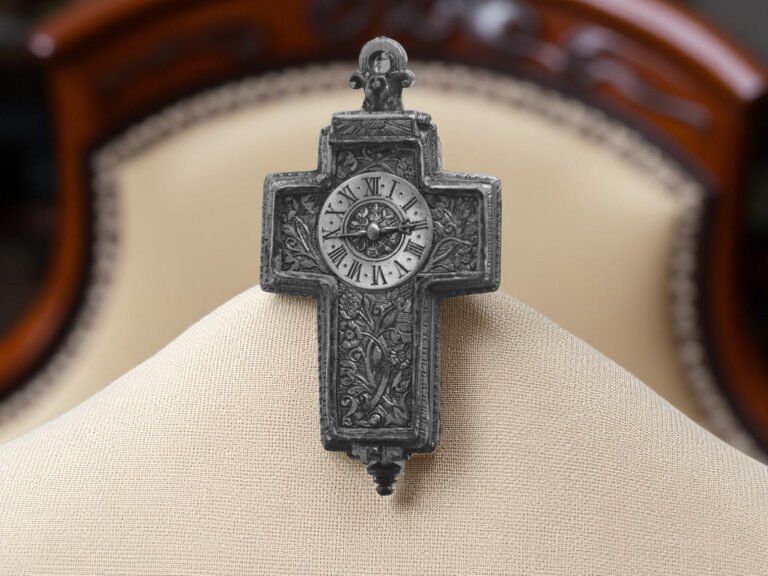
Materials and Symbolism
These devotional timepieces stood apart not only in shape and iconography but in their materials. Rock crystal was a favored medium — painstaking to carve but visually resonant, representing spiritual purity. Cases and inner structures were crafted from gilded brass, silver, or gold, often chased or engraved with religious flourishes. Enamel, used both for dial faces and case decorations, served as the canvas for miniature scenes: the agony in Gethsemane, the Crucifixion, the Resurrection.
Steel components, particularly the blued hands and screws, added both contrast and elegance. Occasionally, more opulent materials like lapis lazuli, mother-of-pearl, or precious stones were used, especially in commissions for ecclesiastical or royal patrons.
More Than Timekeepers
Ultimately, these watches were not utilitarian. They were meant to be contemplated, held, and cherished — functioning as reliquaries of motion, where each tick of the escapement was an echo of divine order. Their owners may have used them during private devotions, in monastic settings, or as symbols of personal salvation. Some even featured concealed compartments for relics or verses.
Today, these timepieces are extraordinarily rare, with many being housed in museum collections—the Louvre, the British Museum, the Patek Philippe Museum in Geneva, and the Walters Art Museum in Baltimore among them. Others rest in private collections.
Sell an Antique Crucifixion Watch
If you have an rare, antique watch, such as a Crucifixion timepiece, contact C. Blackburn Jewelers today for a market appraisal and generous cash offer. To get started, send us a text message with photos of your antique watch to 619-723-8589, or send us an email via the contact form below.
To learn more about our experience in fine timepieces, visit the link: San Diego Watch Buyer.

